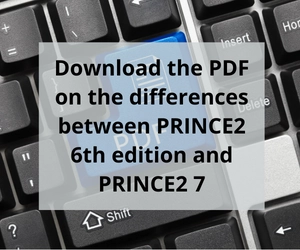PRINCE2® 6th edition vs PRINCE2® 7
Differences between PRINCE2 6th edition and PRINCE2 7 explained by iLEARN
Summary of Topics
- What are the key differences between PRINCE2 7 and the 6th edition?
- What does remain unchanged between PRINCE2 7 and PRINCE2 6thedition?
- Differences in detail between PRINCE2 7 and 6th edition
- Are there differences in PRINCE2 7 and PRINCE2 6th edition exams?
- Conclusions: shall I choose PRINCE2 6th edition or PRINCE2 7?
The PRINCE2® methodology was first created in 1996 and has had six revisions since that time. The last update was released in 2017 and is referred to as PRINCE2 6th edition.
The newest edition of PRINCE2 - PRINCE2® 7 was released in September 2023 and seeks to respond to a number of changes that have taken place in the world and in the discipline of project management in the last years.
This page will provide the key differences between PRINCE2® 6 and 7.
What are the key differences between PRINCE2 7 and the 6th edition?
First of all, there are some new focuses in PRINCE2® 7. They are:
- Integration of People: People are a central part of successful projects and are now integrated into the PRINCE2 method.
- Project performance: sustainability has been added as a seventh project performance aspect to reflect modern organizational needs.
- Digital and data: to meet the needs of project management professionals in an evolving digital era, a digital and data management approach was added.
What does remain unchanged between PRINCE2 7 and PRINCE2 6thedition?
The essence of what a project is has not changed: it is temporary, product-focused and should always have an ongoing business justification. However, the overall structure of PRINCE2 has been updated in this new edition. Principles, practices (what were previously called themes) and a set of processes make up the lifecycle of a project in the way that the previous version also did. But within and alongside those principles, practices and processes there have been changes made.
Differences in detail between PRINCE2 7 and 6th edition
In version 7 of the PRINCE2 official guide, the page count has expanded, now comprising 405 pages compared to the previous 343.
If you want to learn more about the differences in every specific element included in the PRINCE2 guides, download the mapping and change log of differences between the different PRINCE2 versions.
Are there differences in PRINCE2 7 and PRINCE2 6th edition exams?
In the 7th edition of PRINCE2, changes have been introduced to the examination formats at both the Foundation and Practitioner levels.
For the PRINCE2 Foundation exam, the format remains consistent, but the pass mark has been raised from 55% to 60%, requiring candidates to achieve a minimum of 36 correct answers.
For the PRINCE2 Practitioner exam, there are notable adjustments. The PRINCE2 7 Practitioner exam now consists of 70 questions instead of the previous 68. The pass mark has also been elevated to 60%, up from 55%, while the exam duration remains at 2.5 hours. Furthermore, the Practitioner exam will revolve around one of four scenarios found in the new version of the PRINCE2 manual, adding a practical dimension to the assessment process. PRINCE2 5th edition certificates are not accepted as a prerequisite.
Conclusions: shall I choose PRINCE2 6th edition or PRINCE2 7?
PRINCE2 7 represents a significant step forward with changes and enhancements compared to its predecessor, the 6th edition.
It's important to note, however, that if you've already embarked on your journey with the PRINCE2 6th edition, you can continue your learning without any major concerns. The core structure and fundamental knowledge of PRINCE2® remain largely intact.
On the other hand, if you're just starting to explore PRINCE2®, we highly recommend opting for the 7th edition, provided it's available in a language you are fully proficient in, with English being the initial preference. In case the 7th edition isn't accessible in your language, you can confidently pursue certification in the PRINCE2® 6th edition without encountering any significant issues.

 Login
Login